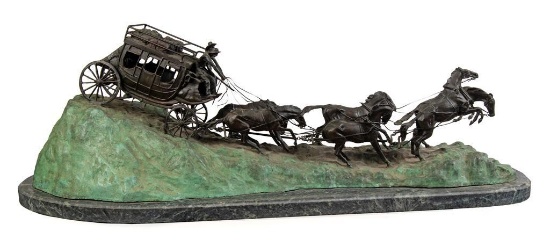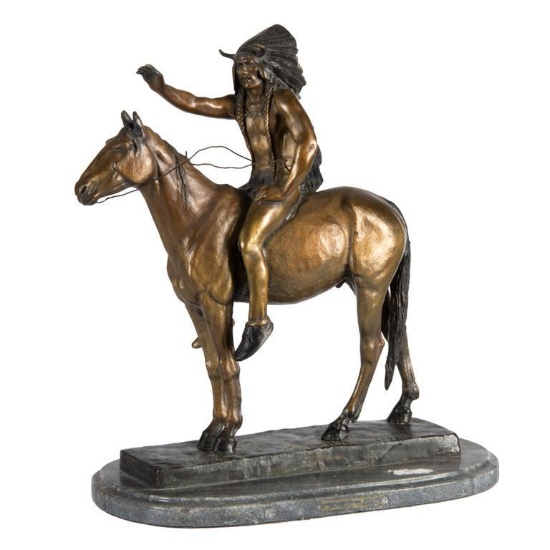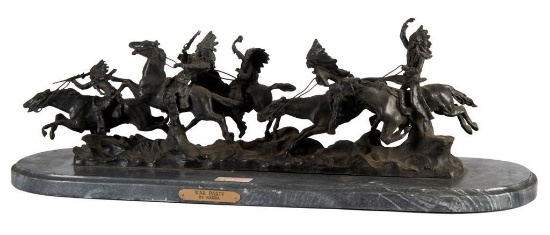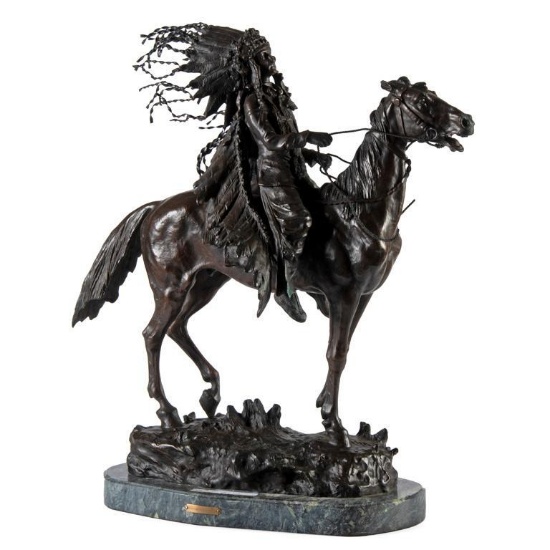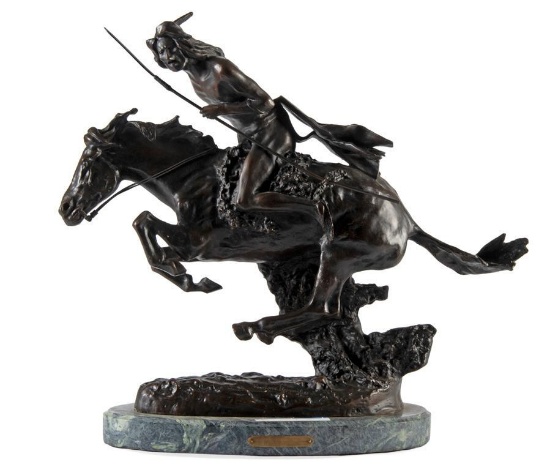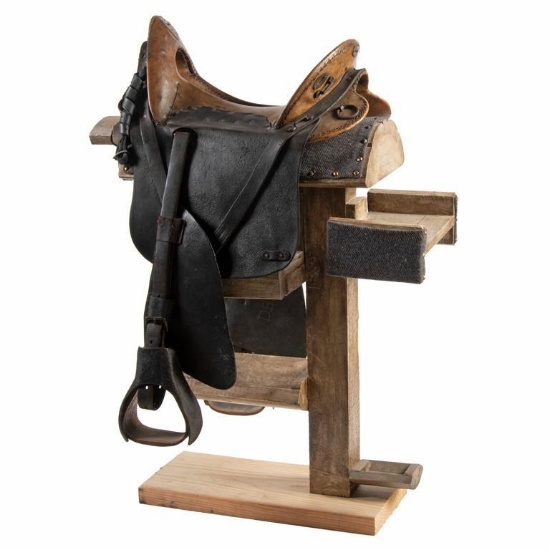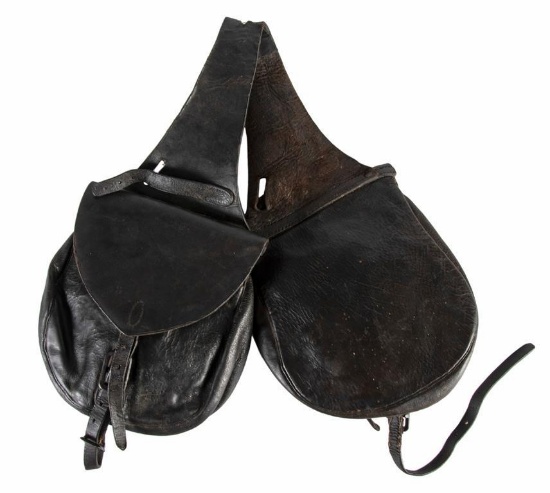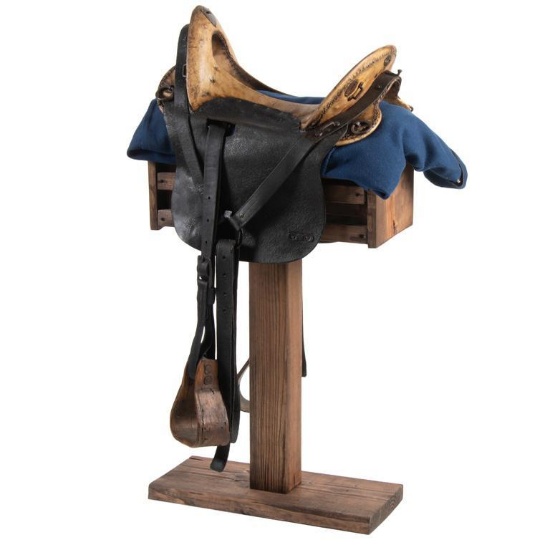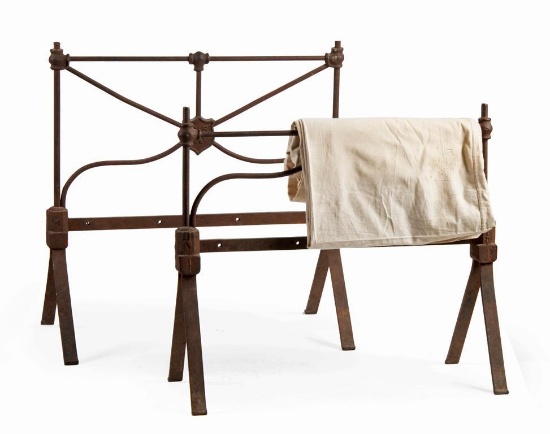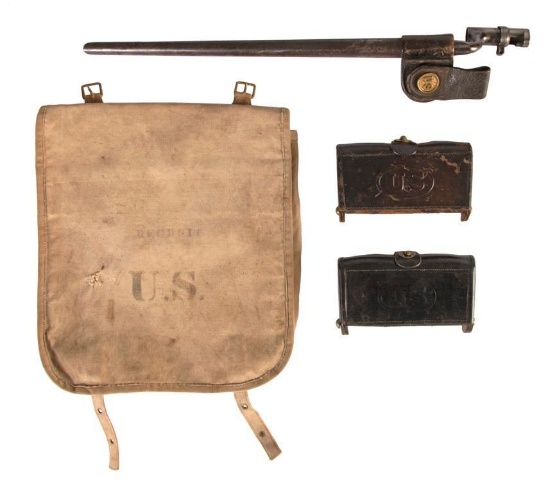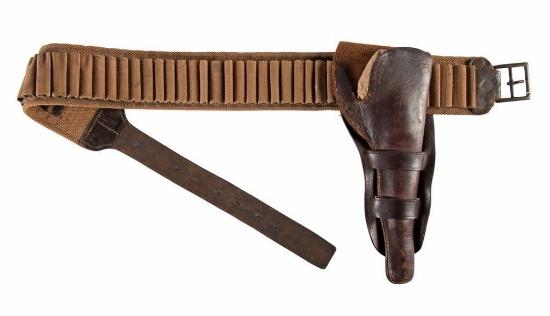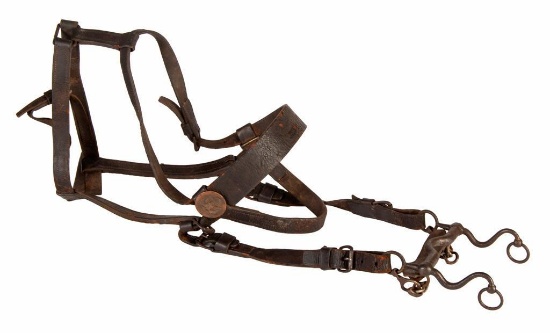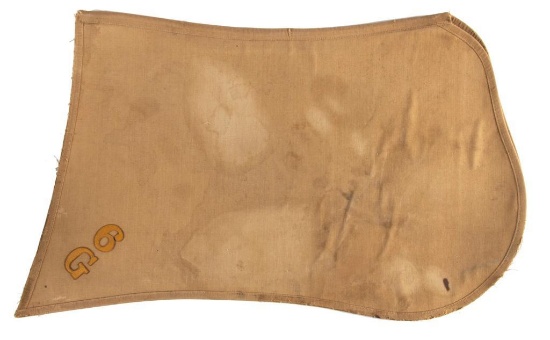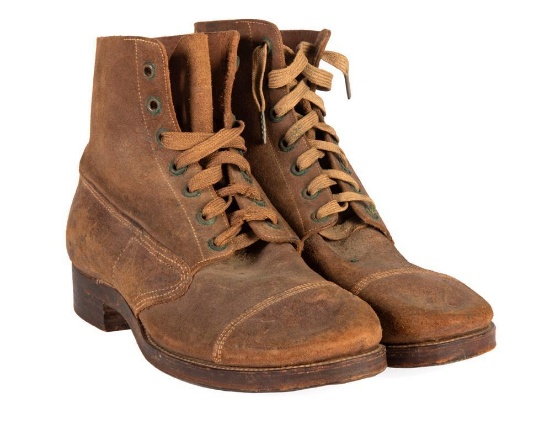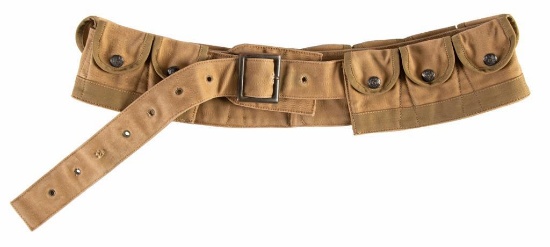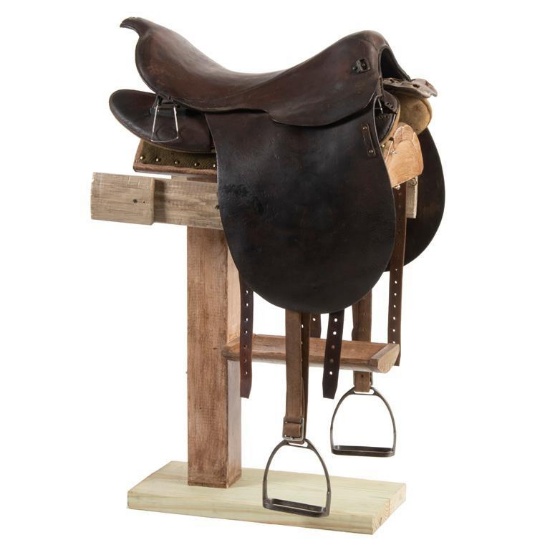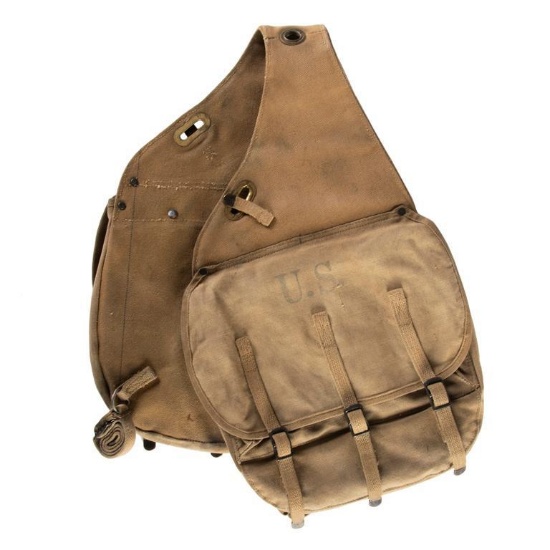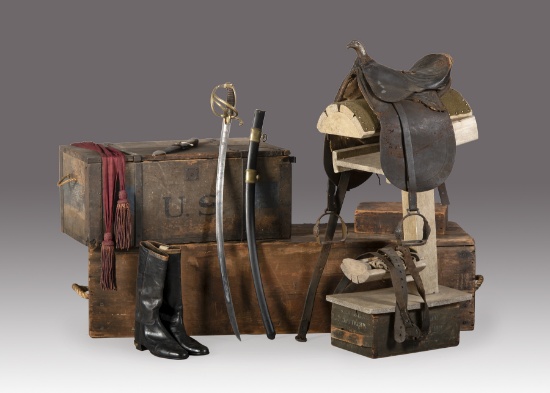
Arms, Armor, and the Early West
Arms, Armor, and the Early West
See Special Terms for additional fees
Cash Payment Discount: 3%
Description
sale of historical artifacts and collectibles, many of which have been featured in numerous historical exhibitions and institutions. Headlining the sale are selections from the General Samuel Houston Collection, victor of the Battle of San Jacinto and first President of the Republic of Texas. These lots include not only artifacts from his early military career including a militia officers chapeau (Lot 72), his field desk (Lot 79), and saddle pad (Lot 77), but also the sword belt (Lot 75), silver spurs (Lot 78) and presentation saber (Lot 74) worn by Houston at San Jacinto. Another artifact from the Battle of San Jacinto, a Mexican General Officer’s Coat attributed to Santa Anna (Lot 91) comes from the collection of James Sylvester, the only color-bearer at the battle as well as the soldier credited with Santa Anna’s capture. Sylvester was employed at the New Orleans Picayune Newspaper and spent many years of his life collecting arms and objects associated with the Texan Revolution to... Show more
Lot Location:
Stagecoach Bronze
Lot # 201 (Sale Order: 201 of 429)
Cold painted bronze western stagecoach scene. Signed "C.M. Russell" with shaped marble base
ht. 13", wd. 43", dp. 15" inches (bronze)
**Overall good condition.**
$2,000-$4,000
Bronze Sculpture of Native American Chief by Carl Kauba
Lot # 202 (Sale Order: 202 of 429)
Bronze sculpture of Native American Chief on horseback.
Signed "C.E. Kauba" with oval marble base.
ht. 17.5", wd. 16", dp. 12" inches (bronze).
**Overall good condition.**
$600-$800
After Cyrus Dallin Medicine Man Bronze Sculpture
Lot # 203 (Sale Order: 203 of 429)
Bronze Native American on horseback. Signed "C.E. Dallin 1899" with oval marble base.
ht. 18", wd. 17", dp. 4.5" inches.
**Overall good condition. Expected Casting imperfections throughout. Break to the horse reign (metal wire).**
$500-$700
The War Party, Bronze Sculpture After Carl Kauba
Lot # 204 (Sale Order: 204 of 429)
Bronze Native Americans on horseback. Signed "Kauba" with oval marble base.
ht. 12", wd. 32", dp. 10.5 inches.
**Overall good condition. Expected casting imperfections throughout. Some missing ends of rifles and loss of rope on trailing horseman.**
$500-$700
Bronze Sculpture of Native American Chief by Carl Kauba
Lot # 205 (Sale Order: 205 of 429)
with shaped marble base.
ht. 23, wd. 23, dp. 10.5 inches (bronze)
**Overall good condition. Minor oxidation throughout sculpture. Break to the metal wire for horses reins.**
$1,000-$2,000
After Frederic Remington "Cheyenne" Bronze Sculpture
Lot # 206 (Sale Order: 206 of 429)
ht. 19, wd. 22, dp. 6 inches (bronze).
**Overall good condition. Warrior is missing the right hand weapon.**
$500-$700
After Charles Marion Russell Will Rogers Bronze Sculpture
Lot # 207 (Sale Order: 207 of 429)
ht. 10.5, wd. 10.75, dp. 4.5 inches (sculpture)
$200-$400
After Frederic Remington "Scalp" Bronze Sculpture
Lot # 208 (Sale Order: 208 of 429)
ht. 22, wd. 19, dp. 8 inches (bronze).
**Overall good condition. Break to the metal horse reins.**
$400-$600
M1859 McClellan Saddle with Rawhide Covered Tree
Lot # 209 (Sale Order: 209 of 429)
The M1859 Rawhide covered McClellan's were used from 1859 through the 1870's. A number of M1859 trees and relic parts have been found on the Custer battlefield. These saddles were classic piece in the period of the Indian War Cavalry from 1865 through the 1870's when they began to replace them with the later era McClellan Saddles. Has a m1859 blue wool cincha with the saddle. Also includes a pair of Civil War stirrups with the hoods on them unlike the pair that was field modified that are included on the saddle.
(SADDLE STAND NOT INCLUDED)
$1,000-$1,200
M1859 Civil War McClellan Saddle Bags Identified to Civil War Captain Elihu Grant
Lot # 210 (Sale Order: 210 of 429)
There is little room for doubt that this set of Model 1859 Saddlebags were owned and used by Captain Elihu Grant, as the set was accompanied by no less than four separate tags identifying them to Capt. Grant. The earliest is a 5 ...? by 2 ...? shipping tag from the E.S. Brown Company in Fall River, Massachusetts, with the inscription written in pencil ?Capt. E Grant?. The source of the tag is significant as the Captain was from Fall River and that is where he is buried. The next tag in the progression is a 3? by 2 ...? manila tag with the inscription written with a fountain pen, ?Civil War Saddle Bags used by Capt. Grant Co C 3 Regt MVM -1862-?. The next tag is a small well worn price tag style that appears to have been a collection inventory tag with a faint inscription, ?CW Saddle Bags used by Capt. Grant Co C 3 Regt MVM 1862?. The last tag was affixed by the last collector who owned these saddle bags, repeating the same information on the other tags. All of these tags will accompany the saddlebags.
Captain Elihu Grant was from Fall River, Massachusetts and was involved in raising the 3RD Regiment of Massachusetts Volunteer Infantry in 1862, eventually serving as the company commander of Company C. Grant was born in either 1820 or 1825 ? there are conflicting records ? in Smithville, New York.
The seat, or yoke connecting the two bags that passes across the back of the saddle, is complete with both leather keys used to secure the saddlebags to the foot loops on the rear sidebar extensions of the saddle. Quite often the seat on these bags are broken or torn, and separated at the saddlebag stud hole, a classic weak point as age, use and poor storage takes its toll. The seat on this set of bags is still intact, strong and pliable, and as a result the bags will display quite well.
The lower tie down strap and buckle is complete on the left hand bag. The buckle and extension is present on the right bag, however the billet is missing. The billet could be easily restored if the new owner so decides. That these straps are present in any form is unusual, as so many of the surviving sets of saddle bags are missing these entire lower strap assemblies. Either due to wear and age, or from being intentionally removed by the soldiers contemporary to the use of the bags as unnecessary when the bags were mounted on the saddle and all of the equipment that made up the cantle roll was in place secured by the coat straps, these straps just didn?t survive.
Model 1859 Saddlebags in decent condition have never been easy to find, and sets with all of the components intact are outright rare. Overall, this is a very respectable set of saddlebags with the added value of being identified to a Civil War veteran, and having survived in very good condition, they will definitely enhance the appearance and value of your Civil War or early Indian War McClellan Saddle.
**Saddle leather has some cracking throughout, heavier in certain areas. There is a tear in the middle of the cross strap. Straps & buckles are all present and intact but more brittle than the bags themselves. Overall very good condition for the age.**
$1,000-$1,500
M1864 McClellan Saddle
Lot # 211 (Sale Order: 211 of 429)
More than likely this saddle was refurbished by one of the federal arsenals therefore no plate would have been added. Also another unusual thing worth noting is that there are four symmetrical filled-in holes on the pommel. They were filled in and blended in but are noticeable. The only plausible explanation is that perhaps during the arsenal rework that screws were put in to reinforce the tree.
(SADDLE STAND NOT INCLUDED)
$1,500-$3,000
Rare M1868 McClellan Saddle with Crupper, Pommel Coat Straps, and Bed Straps
Lot # 212 (Sale Order: 212 of 429)
The M1868 was not a common saddle then, nor is it today in collections. It was manufactured/modified in a very dynamic period and was fast over taken in the field by the leather covered M1870 and M1872 and eventually the M1874. Most M1868 saddles were reconfigured to later models so specimens are scarce today. The saddle has brass moldings at cantle and pommel. This was a major modification done at he arsenals to existing saddles. Includes six original coat strap buckles.
(SADDLE STAND NOT INCLUDED)
$1,500-$2,800
M1869 Saddle Conversion
Lot # 213 (Sale Order: 213 of 429)
The Leavenworth Arsenal and Weir conversions of 1869 included 500 to be covered at the arsenal and 75 at Captain Weir's company. There is no way to determine if this is one of those saddles. The saddle has a modified M1859 civil war cincha.
(SADDLE STAND NOT INCLUDED)
$2,500-$4,000
Rare US Army M1872 Composite Bunk with Original Bed Sack
Lot # 214 (Sale Order: 214 of 429)
This was the standard US Army barracks bed as seen in all US Army photos of the Indian Wars from 1872 until 1904 when a new type of barracks bed was adopted. The M1872 US Army Composite bunk bed head and foot pieces measure 11" wide at the Y feet which run the length wise with the bed and are vertical wrought iron construction measuring 32" wide and 24"tall. They used six inch wide boards that laid length wise from the head to the feet pieces to make up the bed plate form, so this can be adjusted for display whatever distance you want.
These beds are very rare as these were all scrapped for metal after the adoption of the M1904 bed and particularly during WW1 and WW2. Original finish. Included is an original cover that they put straw into to put on the bed.
**Very rare and excellent condition. Or you can display it without the boards. Cover is original and mint condition.**
$1,000-$2,000
Rare M1875 Wagon Driver's Saddle
Lot # 215 (Sale Order: 215 of 429)
The girth on the saddle is one that was of a pattern used on Civilian saddles from well before the civil war and one that has survived through today. Its design that works and requires very little effort to make, so the design has been historically durable. The cords are cotton/wool and date easily to the 19th century. Very little information survived on these saddles.
23 years ago when Dorsey and McPheeters were researching their book on saddles were unable to find and example or anyone that knew of the saddle. They had to use drawings of the saddle in the book. This single example was discovered in an old collection in New York. Only known example to exist. Ken McPheeters has no doubt this is a genuine example of the very rare virtually non existent in any other known collection. To put the saddle in perspective, virtually wherever the soldiers rode the "McClellans" across the west, these saddles were close at hand used by the teamsters who drove supply wagons that supported the columns.
These saddles were used to move the beans, bacon and bullets on which the Army traveled in all of the campaigns on the frontier. Rare saddle great find of the collection. These saddles were not designed nor manufactured at the arsenals, but rather a contract purchase by the army of an already established pattern in use across the nation. In addition to the design of this saddle matching that shown in the army diagram that this one is "US" stamped is key to its identification and it may be the only one left in existence.
(SADDLE STAND NOT INCLUDED)
$2,500-$4,000
M1875 Palmer Brace Belt System Set
Lot # 216 (Sale Order: 216 of 429)
The Palmer Brace system is as follows:
1. Proper Belt with the rectangular buckle with loop on top edge and catch with loop on top edge.
2. complete Brace system with straps for attaching to belt, both straps and either side for haversack and clothing bags and complete with the 3 straps for blanket roll.
3. 1 pair of matching early McKeever Cartridge boxes with flat ends
4. the left and right cloth and haversack bags
5. the proper early M1873 Bayonet scabbard and bayonet.
A full set of Model 1904 Blanket Roll Straps, all full length and in excellent condition, showing their original bright russet leather color and brown japanned lacquer finish on all the buckles and straps ? very likely unissued. The blanket roll consists of four separate straps made from russet leather. The two straps for buckling around the blanket roll near the ends. A third strap with a special spring snap at one end and a buckle at the other connects the first two straps by fastening into the D's. The fourth strap , like the first two but with out the D ring is used to buckle around the middle of the roll.
**Cartridge pouches show wear, one has some chipping and flaking to the leather exterior, one is in really good shape with hardly any wear to the leather. Both swivels are intact and function nicely. Both brass buckles are present and the stitching on both is tight. Can haversack bags show wear with some soiling and fading with minor fraying in isolated spots. Leather straps show some light wear around the edges from use, overall the leather is pliable not brittle with all straps, rivets, and buckles intact. R.I.A. markings are nice and legible. Bayonet & scabbard are nice retaining most of the original finish with patina, and some finish loss. Leather shows wear and cracking but still pliable and stitching is tight. Overall in very good to excellent condition**
$1,200-$1,500
Late Indian War Carbine and Revolver Barracks Rack
Lot # 217 (Sale Order: 217 of 429)
Per the book A Study of the Colt Single Action Army Revolver by Kopec, Graham and Moore, the barracks rack was used during the 1880-1890 period and held Colt revolvers and Springfield .45-70 carbines securely in place with the ability to lock them in position. Hayes states he has never seen one of these racks that was still cut for the Colt single action.
They were modified later by the Army to fit and be used with Colt .38 revolver and Krag Carbines. The leather covered wrought iron straps open, and the gun slides vertical into the rack by sliding it straight in not down. This rack has been altered for the .38 revolver. As it was displayed in the book it was already altered at that time
This is exactly as shown in the Kopec book A Study of the Colt Single Action Army Revolver, page 340. It was originally in the collection of Merlin Schram. Hayes acquired the piece and sold it to Kermit Edmonds where it became part of his 60 year old collection. A superb arms item and all original finish.
**Very good and all original as modified. Very rare and normally only found in the most advanced Indian War and US Cavalry collections.**
$2,500-$3,500
M1885 US Mills Cavalry Canvas and Leather Belt With Holster
Lot # 218 (Sale Order: 218 of 429)
**Canvas/leather belt shows some wear with some minor staining in spots, the leather straps have some light cracking but still pliable and supple. The rivets and stitching are tight. One small spot is fraying off with a couple of very small holes. Leather holster shows wear with some minor scuff marks and a few minute chips near the bottom and overall being broken in, but still supple and pliable. No holes or tears and stitching is tight. Overall in excellent condition for age.**
$1,000-$1,500
Rare Model 1903 US Army Experimental Cavalry Halter-Bridle Set
Lot # 219 (Sale Order: 219 of 429)
The Army regarded the concept of combining the halter and bridle in one unit as experimental and labeled it as such, not only in the initial Ordnance Department drawings, but continued to do so some fifteen years later when the Ordnance Manual 1719 was published in 1917. While known to exist from the Ordnance Department records and manuals, finding one of these early pieces on the loose is considered by some in the cavalry equipment collecting community as being nearly impossible.
**Leather shows signs of use & age but is solid. This halter bridle is complete with all the straps, buckles, and full length billets. The surface of the leather is crazed and there is some minor flaking and cracking. With some conditioning and proper mounting this set will display nicely in the future. The bit and metal parts have some surface rust and patina. Overall in excellent condition for the age.**
$1000-$1,200
Model 1904 Enlisted Man's Service Saddle Cloth of The 6th Regiment Company G "R.I.A." Marked
Lot # 220 (Sale Order: 220 of 429)
Created during the Civil War, the 6th Cavalry Regiment saw continued extensive service on the Western Frontier during the Indian Wars and the Peking Expedition.
In August of 1907, the regiment was sent to the Philippine Islands in accordance with the system of unit rotation of that era. After this period of active service in the field which resulted in four Medals of Honor awarded to troopers in the 6th, the regiment returned to the United States in 1909.
Beginning in 1910, in response to the unrest in Mexico the regiment began a series of rotations into assignments along the southern international border. In 1913, the regiment was deployed to Texas City, Texas with individual companies scattered along the border. While the 6th does not appear in the order of battle for General Pershing?s expedition into Mexico, the official history of the regiment states the regiment took part in the campaign. This particular Model 1904 enlisted man?s service saddle cloth would have been in the inventory of the 6th Regiment during the 1904-1918 years and certainly could have been issued to a trooper in Company G.
Model 1904 Enlisted Man?s Service Saddle Cloths are anything but common ? as the name implies, they were intended to be used in the field, and in the context of the service experienced by the 6th during this period, harsh environments and constant use took a heavy toll on the soldiers? equipment. This specimen is particularly notable as it features the rare applied enameled leather unit insignia. The yellow enameled leather numerals and letters ?6 G? on both rear corners still retain virtually all of the vibrant yellow color, and survive in full form with no loss of surface nor any wear or damage to the edges of the leather.
In addition to the regimental numerals on the saddle cloth, there is also a faint, but still discernable ?ROCK ISLAND ARSENAL? ink stamp on the underside of the right side panel, just off of the spine. The underside of the left rear corner is bears an ink stamp ?32?, a unit applied inventory control number.
As the army?s designation implies, these khaki canvas ?service? saddle cloths were intended to be used in the field and due to the heavy use in extreme conditions to which they were exposed, few survive today in decent condition. This was confirmed when having handled dozens of these saddle cloths held in museum and private collections in the course of the research for The American Military Saddle 1776-1945, it became quite apparent that the majority of these cloths which did survive were subjected to heavy use ? almost to destruction - and they exhibited severe wear. Understandably, the thorough soaking of horse sweat and the accumulated and concentrated deposits of body salts from the horse rendered these cloths especially prone to deterioration and eventual disposal.
Hence, surviving examples of these cloths in any condition are not common today, making those worthy of displaying relatively scarce and further still, specimens identified to historically significant units even more so.
The added value of this Model 1904 Enlisted Man?s Saddle Cloth being identified to a cavalry regiment and troop who were present at such significant events in history such as the relief of Peking, the Philippine Insurrection, and the Punitive Mexican Expedition, will clearly make this piece a key addition to any saddle collection.
**The olive drab duck material still retaining the rigid, sized nature of the fabric when it was new, is not misshapen nor is the fabric weakened or torn as seen on many heavily used examples. The fabric does show evidence of use with some lightened areas where the saddle soiled the canvas and the material was cleaned. The canvas spine is strong and fully intact. The edge binding is fully present with some wear along the edge, commensurate with the extent of the unit?s service, but not to the point that it detracts from the appearance of the cloth when on display. All the seams are intact and strong. Overall in excellent condition.**
$1000-$1,500
Scarce Pre WW1 Rough leather Suede Cavalry Boots
Lot # 221 (Sale Order: 221 of 429)
**Leather suede has a few scuff marks but still supple and pliable. Stitching is tight on suede and to the sole. Green patina from oxidation around the lace loop holes (can be cleaned). Original laces are in great shape with metal tips still intact. Overall in excellent condition.**
$1,000-$1,500
M1910 Mills US Officer's Belt Set with Web M1902 Saber Hanger and Swivel Holster
Lot # 222 (Sale Order: 222 of 429)
**Set shows light wear with one small stain on the belt and a little fraying on the holster edge. Overall set is in excellent condition.**
$1,000-$1,500
M1911 Rock Island Arsenal US Cavalry Bandoleer
Lot # 223 (Sale Order: 223 of 429)
**Canvas belt shows light wear with some very light fading, and missing just one belt hole metal ring. Belt is overall in excellent condition**
$1,000-$1,500
US M1912 McClellan Saddle
Lot # 224 (Sale Order: 224 of 429)
Along with the saddle a full set of new equipment was also developed including a swiveling saber hanger for the newly adopted Patton saber, a bucket to support the butt of the '03 Springfield rifle. Pommel bags and canvas ration bags. A total of 8,893 were produced. Many were issued to troops sent to Mexico during the Punitive Expedition against Pancho Villa.
Between weaknesses discovered in the design of the saddle tree, the looming war in Europe and the hundreds of thousands of McClellan saddled in storage doomed this interesting saddle. Most saddles and their related equipment were returned to arsenals and were destroyed leaving very few around for collectors.
(SADDLE STAND NOT INCLUDED)
$2,500-$3,500
Rare U.S. Army Model 1924 Substitute Canvas Saddle Bags
Lot # 225 (Sale Order: 225 of 429)
One of the lessons learned by the army during the pell-mell procurement and production of equipment as the US entered World War One was that certain critical materials would quickly be in short supply. One of these war materials was leather and both the Ordnance and the Quartermaster Departments found ways to alleviate the problem with new designs and new materials.
As indicated by the army?s name for these canvas saddlebags, save for the materials from which they were made, the design was for all intent and purposes, identical to the standard Model 1924 leather saddlebags.
At this time, there are only three sets of these Model 1924 Substitute Canvas Saddle Bags known to exist. All three are ink stamped on the inside of both flaps, ?JQMD 1932?, indicating they were manufactured at the Jeffersonville Quartermaster Depot. While this date appears on all three known sets, that alone does not preclude that others could have been produced before 1932, however there are no known surviving specimens which bear an earlier date.
Adding to the mystery is the only known JQMD Quartermaster Department drawing ? a detailed blue print of the manufacturing pattern of these bags- is dated 1939, indicating these bags were still considered to be a viable piece of equipment on the threshold of World War Two. There is no known record of how many sets of these Model 1924 Substitute Canvas Saddle Bags were produced, or how many were subsequently issued.
As the horse cavalry was entering the twilight of its existence, it is unlikely many of these substitute saddlebags were issued for anything but testing for serviceability, however these sets are one of the most desirable due to their rarity.
**This set of Model 1924 Substitute Canvas Saddlebags shows no signs of having been issued or used in the field, and is in remarkably fine condition. Both of the bags are in excellent condition, with all of the seams intact and both are complete with the closing billets and buckles. There are no signs of wear nor any holes or tears in the canvas, and only very minor soiling due to storage. The flaps are both stenciled on the outer surface with a legible "US", and on the inside of the flaps with ?JQMD 1932?. The seat or yoke connecting the two bags that passes across the back of the saddle is complete with both web strap keys used to secure the saddlebags to the foot loops on the rear sidebar extensions of the saddle, and the foot loop reinforcement plates on each side, and the round reinforcement plate for the saddlebag stud on the saddle in the center, are all intact with no tearing or wear. Both of the bag liners are present, the near side (left) bag liner having the correct utensil pockets.
Of particular note, both sets of the original full length web tie downs straps are present on the bags. Each bag has a shorter strap which was buckled to the ?D? rings on the girth, and a longer strap which passed under the horse and buckled to the opposite bag. All four straps retain their metal tips and none show any wear or fraying. That these straps survived intact on these bags is nothing short of remarkable as they of a size that they could have been removed for so many other applications through the years. Very special in both rarity and condition, these unique saddle bags would be appropriate to display on any of the 20th century US Army Saddles for which the McClellan Saddlebags were issued, and would enhance your cavalry display to a level few collectors will attain. On the M1928 McClellan Saddle. Overall in excellent condition**
$1,000-$1,500


 x Cancel
x Cancel